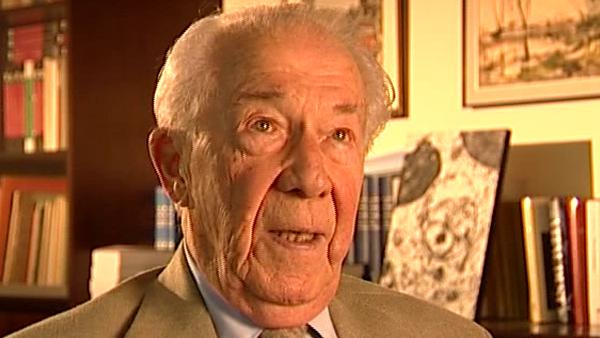NEXT STORY

Glycogen storage diseases: Autophagy
RELATED STORIES

NEXT STORY

Glycogen storage diseases: Autophagy
RELATED STORIES


|
Views | Duration | |
|---|---|---|---|
| 41. The sixth enzyme: Uricase | 157 | 04:50 | |
| 42. The discovery of lysosomes | 1 | 447 | 02:32 |
| 43. A passion for bioenergetics | 128 | 03:06 | |
| 44. Uptake and digestion in lysosomes | 132 | 04:10 | |
| 45. Autophagy: Self-eating by cells | 257 | 03:04 | |
| 46. 'Suicide bags': Lysosomes in pathology | 140 | 02:15 | |
| 47. Pathological implications: Osteoclasts and osteoblasts | 95 | 03:12 | |
| 48. Pathological implications: The work of Géry Hers | 97 | 02:32 | |
| 49. Glycogen storage diseases: Géry Hers and Gerty Cori | 131 | 04:46 | |
| 50. Glycogen storage diseases: Autophagy | 116 | 02:30 |


And then, going back to the Coris who, of course, were the first pioneers in the study of glycogen... after I had left their laboratory and for reasons that had nothing to do with my being there, but, anyway, the latest interest of Gerty Cori, the wife of Carl, who shared the Nobel Prize with him... her major interest became the study of congenital glycogen storage diseases. These are a group... a set of diseases which are all inborn, congenital, genetic diseases in which, for one reason or another, glycogen accumulates in abnormal quantities in various types of cells. Therefore they are called glycogen storage disease. And so she studied the biochemical mechanisms that were involved in these diseases. She found one that was due to the absence of glucose 6-phosphatase, for instance. Another one was due to the absence of debranching enzyme and so on – several types – and among those different types she had described one called glycogenosis type II where she didn't find any abnormality that she could detect. When she died... I think it was probably in 1957; she died early. Carl lived much longer. She died of... I think it was aplastic anaemia or some rare blood disease. My friend and colleague, Hers, took over this job of studying biopsies from patients with different diseases and trying to find out... specially carbohydrate diseases, to find out by enzyme assays, what enzymes might be deficient or missing in those tissues. And so he became an expert on glycogen storage diseases and ran into a few samples of this glycogen storage disease type II which is also called Pompe's disease – it's the name of a Dutch paediatrician who described the first case sometime in the '30s – and, like Gerty, Hers was not able to find any deficiency in an enzyme involved in the known metabolism of glycogen. In fact, those children had no excuse for being sick because they would respond normally if you gave them glucagon or epinephrine – they would release glucose in their blood stream like anybody else – so there was no explanation for the storage of the glycogen, and Hers thought, well, an enzyme has been, not described, but postulated by, I think, Bill Whelan, probably, and maybe I should try and look for this enzyme in their diseased tissues. This was an enzyme assumed to be a transglycosylase, an enzyme that would transfer glycoside residues from maltose to glycogen, or from glycogen to maltose... whatever. And so he devised an assay for this hypothetical enzyme, which doesn't exist, actually, but in which radioactive maltose was used as a substrate, and he was expecting to find radioactivity in glycogen; and, in fact, he did not find radioactivity in glycogen but what he found was that there was in liver an enzyme that would split maltose... he called it maltase. And, by accident, having extended this kind of assay to a sample of a liver from a child afflicted with this disease, glycogen storage disease type II, found that this particular activity was missing.
Belgian biochemist Christian de Duve (1917-2013) was best known for his work on understanding and categorising subcellular organelles. He won the Nobel Prize in Physiology or Medicine in 1974 for his joint discovery of lysosomes, the subcellular organelles that digest macromolecules and deal with ingested bacteria.
Title: Glycogen storage diseases: Géry Hers and Gerty Cori
Listeners: Peter Newmark
Peter Newmark has recently retired as Editorial Director of BioMed Central Ltd, the Open Access journal publisher. He obtained a D. Phil. from Oxford University and was originally a research biochemist at St Bartholomew's Hospital Medical School in London, but left research to become Biology Editor and then Deputy Editor of the journal Nature. He then became Managing Director of Current Biology Ltd, where he started a series of Current Opinion journals, and was founding Editor of the journal Current Biology. Subsequently he was Editorial Director for Elsevier Science London, before joining BioMed Central Ltd.
Tags: 1957, Carl Cori, Gerty Cori, Géry Hers, JC Pompe, Bill Whelan
Duration: 4 minutes, 46 seconds
Date story recorded: September 2005
Date story went live: 24 January 2008